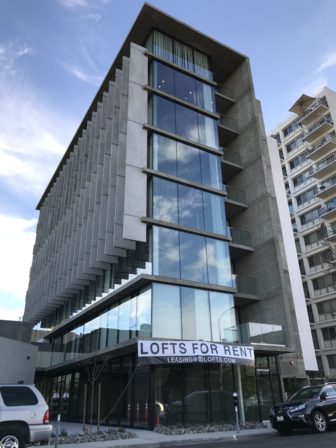Mission Hill Heritage’s Legal Challenge Moving Forward
A Comment on Building Heights and Affordability
By Barry E. Hager

The Fort exceeded building height limits by adding a few affordable units with the remainder being extremely unaffordable.
The legal challenge filed by Mission Hills Heritage (MHH) to the new Uptown Community Plan reached a milestone last month with completion of the administrative record. MHH’s legal challenge was filed under the California Environmental Quality Act (CEQA), and is based on flaws in the environmental analysis underlying the community plan update. The just completed administrative record, which is a compilation of all the documents relating to the community plan update process, consisted of 187,010 pages (that number is not a mistake!), with an index alone that is 183 pages long. Briefing will take place in June and July, with a court hearing after that.
As background, in November 2016 the City Council adopted a last minute re-write of the Uptown Community Plan that had been in the making for over seven years. Only days before the City Council voted, the Planning Department threw out land use maps that had been developed through years of community input and replaced them with maps based on the old 1988 plan. Similarly, the environmental analysis underpinning the project was hastily recrafted to fit the revised plan without properly analyzing and addressing that plan’s numerous, unmitigated impacts on the community. In an unprecedented move, the Planning Department ignored extensive recommendations from Uptown Planners, the City’s officially recognized community planning group for Uptown.
The resulting community plan will invite irreparable damage to the character of Mission Hills. MHH’s primary concerns include that the new community plan will allow new buildings up to 100’ tall or higher in the commercial core area of Mission Hills around Goldfinch and Washington Street, and that the new plan includes no timetable for processing potential historic districts identified many years ago for the Mission Hills neighborhood.
Alarmed by the threat of very tall buildings that are out-of-scale with our community, Mission Hills residents had been pushing to make permanent an interim 50’ building height limit in the commercial core area. But the Planning Department and City Council ignored almost 900 signatures on a petition supporting the permanent 50’ building height limit, instead adopting a 100’ limit with a weak discretionary review process for projects in the range of 50’ to 100’. As we have seen with The Fort on the corner of Hawk and Fort Stockton Drive, a developer can still exceed any height limit, by adding a few “affordable units” under the City’s Affordable Housing Density Bonus Program, and still charge other renters $3600-$4500 monthly for approximately 1000 square-foot units. Without a lower base height limit, projects can go even taller — and just as expensive.
With growing public concern over housing affordability, the connection between building heights and affordability has come into focus. Unlike the City’s Affordable Housing Density Bonus Program which allows a developer to exceed any building height limit by adding a limited number of affordable units, newly proposed State legislation would encourage more affordable housing within existing building height limits. AB 2372, proposed by San Diego Councilmember Georgette Gomez and introduced by Assemblymember Todd Gloria, would authorize the use of a new floor area ratio that would encourage smaller and therefore less expensive housing units, while maintaining that project heights will continue to be regulated by the underlying base zone. Whether or not you support AB 2372, there is an implicit recognition that allowing more building height does not result in more affordability. We hope that our local leaders in the City will recognize that allowing 100’ plus building heights in Mission Hills will do nothing to improve housing affordability.
Please consider contributing to help defray the cost of MHH’s lawsuit. For more details, visit www.MissionHillsHeritage.org.
Category: feature, Local News







